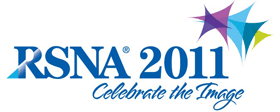
Abstract Archives of the RSNA, 2011
Jeanne Griffin Hill MD, Presenter: Nothing to Disclose
Maura Carey Hege, Abstract Co-Author: Nothing to Disclose
Paul J. Nietert PhD, Abstract Co-Author: Institutional research contract, General Electric Company
Amy Wahlquist MS, Abstract Co-Author: Nothing to Disclose
Susan J. Ackerman MD, Abstract Co-Author: Nothing to Disclose
Leonie Gordon MD, Abstract Co-Author: Nothing to Disclose
To develop and test a three part Objective Structured Clinical Examination (OSCE) of radiology specific communication skills: 1) communicating imaging results accurately and effectively, 2) obtaining informed consent for an image guided procedure, and 3) discussing a proposed VCUG (including radiation risks) with an anxious parent.
Sixteen radiology residents, 8 1st and 8 3rd yrs, participated. In the first section, the residents dictated 5 plain film exams. The reports were evaluated utilizing a qualitative 5 point Likert scale and a checklist based on the ACR Practice Guidelines for Communication of Imaging Findings. Using standardized patients, the residents obtained informed consent for an ultrasound guided paracentesis and discussed with an anxious mother the risks and benefits of a VCUG for a child with recurrent UTIs. Each patient scenario was evaluated by a faculty preceptor, the standardized patient, and the resident. Performance on each of the 3 segments of the OSCE was compared between 1st and 3rd years. Data from faculty evaluations of resident communication skills were collected from a web-based evaluation tool (E-Value) for the previous 6 months and correlated with the results of the OSCE. Resident feedback about the OSCE was also obtained.
Resident responses were very positive, 1st yrs > 3rd. 100 and 93.75% of the participants agreed or strongly agreed that the OSCE improved their effectiveness in obtaining informed consent and in counseling a parent about a VCUG, respectively. 81.25% felt that their participation increased awareness of the importance of communication to the practice of radiology and improved their ability to communicate results in a radiology report. Interestingly, there was no significant difference in performance between the 2 resident groups for each section of the OSCE. Other than positive correlations of 0.88 (p <.0001) for the Dictation Checklist of a KUB and of 0.83 (p <.0001) for Preceptor Evaluation of the Informed Consent scenario, there was limited significant correlation with the 6 month summative faculty E-Value scores.
A communication skills OSCE is a viable educational and evaluation tool with the most potential utility in the first year of radiology training.
A Radiology Communication Skills OSCE is a potentially valuable tool to teach and measure specific communication/interpersonal skills of radiology residents.
Hill, J,
Hege, M,
Nietert, P,
Wahlquist, A,
Ackerman, S,
Gordon, L,
Achieving Excellence in Communication Skills: Development and Implementation of an Objective Structured Clinical Examination to Evaluate Radiology Specific Communication Skills. Radiological Society of North America 2011 Scientific Assembly and Annual Meeting, November 26 - December 2, 2011 ,Chicago IL.
http://archive.rsna.org/2011/11004442.html

